| ← back |
Colonial Meetinghouses Featured in this Project |
next → |
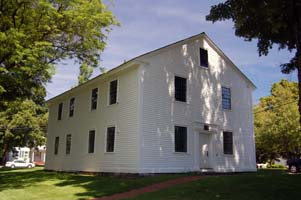 Name of Meetinghouse: Lynnfield Meeting House
Name of Meetinghouse: Lynnfield Meeting House
Street Address of Meetinghouse: 617 Main St., Lynnfield, MA Year(s) Built: 1714 National Register of Historic Places Designation: yes - 1976 Massachusetts State Register of Historic Places: yes Organization responsible: Lynnfield Historical Commission Organization's address: 55 Summer Street, Lynnfield, MA 01940 Organization's web site: LynnfieldMeetingHouse.org Town web site: Town of Lynnfield This page was last modified on: Apr 03, 2023 Acknowledgements: The text below is taken from a pamphlet prepared by the Lynnfield Historical Commission, and has been used by permission.
On November 17, 1712 by order of the General Court, that part of Lynn now called Lynnfield was established as a parish. This would free the inhabitants from paying parish taxes to Lynn as soon as a meetinghouse could be built. On November 22nd, 1713, 32 men and one woman voted to build the meetinghouse, chose a site, and subscribed 130 pounds to pay for it. The deed of land on which this building stands was dated "this seventh day of Decembir 1714 and in ye reign of our sovereign Lord George, King of Great Britain, etc." The deed further reads "all that land whereon ye sd precinct meetinghouse now standeth...."
As originally built, the meetinghouse was almost square.
The pulpit stood upon the northeastern side, a sounding board above.
There were three outside doors with large horse blocks for dismounting before each.
In 1751 it was voted to plaster, clapboard, shingle, and install new window frames. In 1782, the meetinghouse was literally cut in two and a fourteen foot section inserted in the middle. In 1800 it was voted to raise $100 to paint the meetinghouse; the next year the vote was rescinded, and fifty years passed before it was finally painted.
However, the lower hall soon served the community in new ways. It served as the primary school in the center district until the two room center school was built on Main Street in 1903, and then became the fire station for Lynnfield Center and was known as the "chemical house." Large barn doors replaced the original door on the Main Street side of the building, part of the floor was lowered to accommodate the fire engines, and in 1918 a belfry was added to house the large bell which served as the fire alarm. The bell was installed on a block of granite on the Common in 1964.
What to look for in the meetinghouse: Architecturally, the meetinghouse was the simple and strictly functional design typical of New England buildings of the period. The entire frame is of oak, the roof trusses being unusual in that they are braced by a process called "crowning" used in ship building and old barns of Europe. If you will go upstairs and look up at the ceiling, you can see these trusses as well as the oak beams and wooden pins used to join them. You will notice that the two center beams appear more worn than the end beams. When the extra 14 feet were added to the building in 1782, pine was used instead of oak, and through the years fell victim to the powder post beetle. When the Historical Society removed the ceiling hiding the rafters in 1960, the damage was discovered and the beams treated.
|
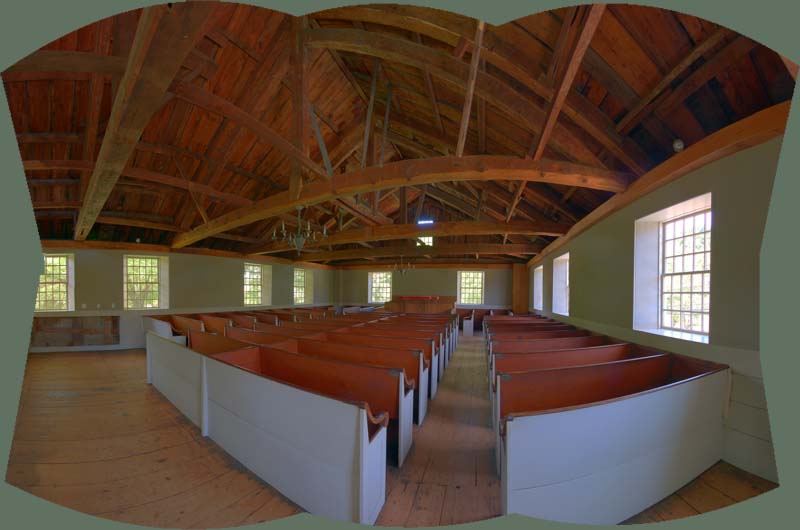
|
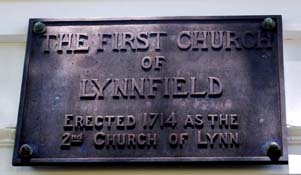
|
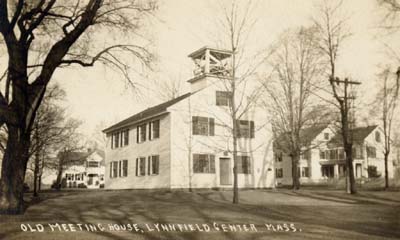
|
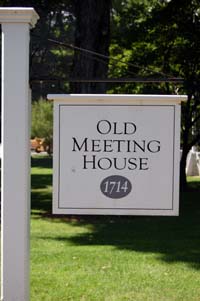 The meetinghouse is thought to be the third oldest Puritan meetinghouse in New England still standing on its original "green,"
and it claims to be the second oldest active meetinghouse in New England.
Built 61 years before the Revolutionary War, it is older than the Old South Meetinghouse, Faneuil Hall, or King's Chapel in Boston.
As one noted historian has said, 'it is without question the most historic building within the limits of the original town of Lynn.'
The meetinghouse is thought to be the third oldest Puritan meetinghouse in New England still standing on its original "green,"
and it claims to be the second oldest active meetinghouse in New England.
Built 61 years before the Revolutionary War, it is older than the Old South Meetinghouse, Faneuil Hall, or King's Chapel in Boston.
As one noted historian has said, 'it is without question the most historic building within the limits of the original town of Lynn.'
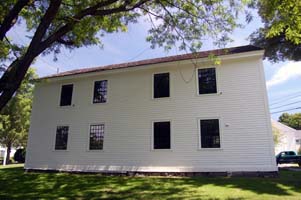 There were galleries on three sides where the slaves and hind men sat and where, in one corner, the gun powder was stored.
The building had neither paint nor plaster, and had no steeple or provision for heat until a stove was added in 1824.
There were galleries on three sides where the slaves and hind men sat and where, in one corner, the gun powder was stored.
The building had neither paint nor plaster, and had no steeple or provision for heat until a stove was added in 1824.
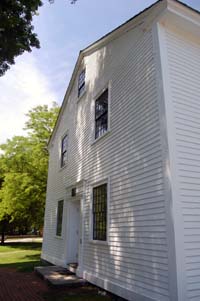

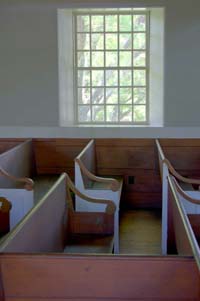 In 1832, eighteen people dissented from the growing Unitarian theology and left to build their own church across from the meetinghouse.
This still stands as the chapel of the Congregational Church.
In 1836 the remaining members, burdened by the cost of maintenance of the building, proposed to the town that a second floor be put in where the galleries were,
so that the upper floor could be used for church services and the lower story be given to the inhabitants of Lynnfield for a town house
provided the town of Lynnfield pay one half of the cost of the expenses and repairs.
The proposal was accepted and the lower floor was used as a Town Hall and meeting place for over fifty years.
Dedication of a new Town Hall in 1892 brought about the final separation of church and state as all civic activities were transferred to the new building.
In 1832, eighteen people dissented from the growing Unitarian theology and left to build their own church across from the meetinghouse.
This still stands as the chapel of the Congregational Church.
In 1836 the remaining members, burdened by the cost of maintenance of the building, proposed to the town that a second floor be put in where the galleries were,
so that the upper floor could be used for church services and the lower story be given to the inhabitants of Lynnfield for a town house
provided the town of Lynnfield pay one half of the cost of the expenses and repairs.
The proposal was accepted and the lower floor was used as a Town Hall and meeting place for over fifty years.
Dedication of a new Town Hall in 1892 brought about the final separation of church and state as all civic activities were transferred to the new building.
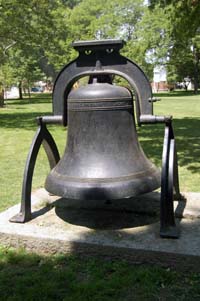 In May of 1960 the dedication of the present fire and police station brought an end to this era in the meetinghouse.
The town appropriated $2000 to remove the belfry, replace the fire engine doors and restore the windows on the main street end of the building.
The Lynnfield Historical Society, founded in 1954, became custodian of the meetinghouse under the ownership of the town of Lynnfield.
In 2021, the custodianship of the building was given to the Lynnfield Historical Commission, a town-appointed board.
In May of 1960 the dedication of the present fire and police station brought an end to this era in the meetinghouse.
The town appropriated $2000 to remove the belfry, replace the fire engine doors and restore the windows on the main street end of the building.
The Lynnfield Historical Society, founded in 1954, became custodian of the meetinghouse under the ownership of the town of Lynnfield.
In 2021, the custodianship of the building was given to the Lynnfield Historical Commission, a town-appointed board.
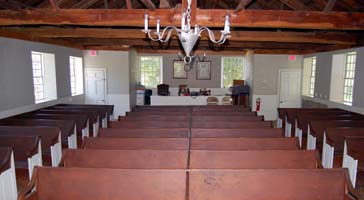 The pine pews reflect the architecture of the early 19th century.
On the underside of some of the seats is the annual cost ranging from $8.00 in the front to $4,50 at the rear of the room.
A copy of one of the original deeds, which were conveyed from one owner to another like real property, is on exhibit on the first floor.
It was 1908 before the congregation experimented with free pews.
The pine pews reflect the architecture of the early 19th century.
On the underside of some of the seats is the annual cost ranging from $8.00 in the front to $4,50 at the rear of the room.
A copy of one of the original deeds, which were conveyed from one owner to another like real property, is on exhibit on the first floor.
It was 1908 before the congregation experimented with free pews.